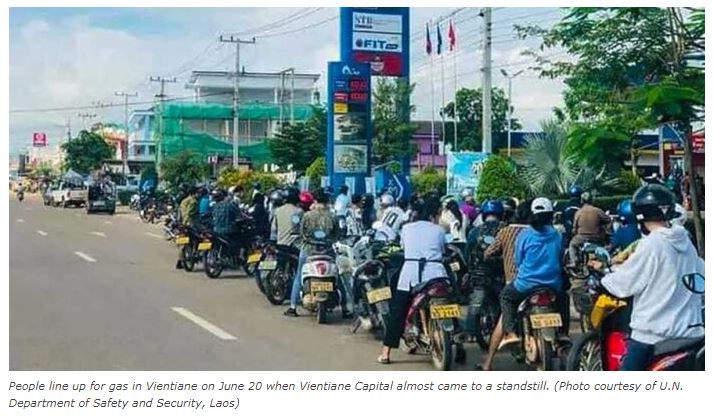Laos’ Financial Crisis Can Be an Opportunity for Reform
Country’s previous growth trajectory was not sustainable, writes Kanni Wignaraja, U.N. assistant secretary general and director of the U.N. Development Program’s Asia and the Pacific bureau. Ricarda Rieger is UNDP’s resident representative in Laos.
This past June, Vientiane almost came to a standstill. Fuel shortages stunted traffic and long lines formed at gas stations around the Laotian capital, as motorists waited patiently to fuel up.
As the price of fuel skyrocketed, farmers who needed diesel for machinery to plow their fields could no longer afford the cost. Some abandoned farming altogether and instead went abroad in search of work.
Others decided to plant rice only for their own needs. Around 20% could not afford to plant any rice at all, according to the U.N. Food and Agriculture Organization.
These are just some of the compounding impacts of the multiple shocks hitting Laos from the COVID-19 pandemic to the global food and fuel crisis following the war in Ukraine. These have derailed and set back decades of development progress.
Across the world, inequality is on the rise. U.N. Development Program estimates that the current cost of living crisis is likely to push 71 million people into poverty. The damage from extreme weather events due to climate change is generating substantial physical, human and economic costs. Biodiversity is on the decline.
Many policy and investment choices, as well the values that underpinned them, have promoted socially, economically or environmentally unsustainable development trajectories. Sometimes, this was due to a lack of data and analytics that could have provided an impartial review of trade-offs.

Laos’ recent economic performance speaks to these realities. With a 7% growth rate of gross domestic product for over two decades, Laos has been one of the fastest-growing economies in Southeast Asia.
Its growth, though, began to slow in 2018 and 2019, partly due to natural disasters. With the onset of the COVID-19 pandemic in 2020, GDP growth fell to its slowest pace in three decades. The war in Ukraine then further exposed some of the country’s structural weaknesses.
The economic stresses that have unfolded in Laos are reflected in its growth pathway. Quality job creation and productivity have lagged.
Hydropower and mining have rapidly expanded, becoming dominant sectors and accounting for 21% of economic output last year. These capital-intensive sectors represent just 1% of employment, however.
Investment to expand these two sectors, as well as transportation infrastructure, have been financed by external borrowing, but these projects have yet to yield revenue, due to long gestation periods.
Even before the pandemic, Laos was at high risk of debt distress, according to previous International Monetary Fund assessments. Public and publicly guaranteed debt went from about 70% of GDP in 2019 to 88% in 2021, according to government figures.
Economic expansion, meanwhile, has come at a cost to Laos’s most valuable resource, the environment, due to growing deforestation and forest degradation. As the economy grew, there has also been a sharp increase in income inequality. (was also a sharp increase in income inequality)
Changing course is not easy. Yet crises provide an opportunity for advancing reforms.
Immediate measures for Laos would center on addressing its debt and creating macroeconomic stability.
This can come about only through reforms in government expenditure, better management of revenue and debt, and addressing corruption. These steps can then allow the country to better absorb shocks associated with the interdependent risks of climate, environment, the economy, and the pandemic and other health emergencies.
Raising revenue domestically is vital for restoring fiscal stability. Such funds can then be reinvested in productive capacity like health care and education. Efforts have been underway to improve tax collection and administration, increase the tax base and introduce new tax instruments — such as royalties, duties, and tariffs — but implementation of these reforms could be expedited.
Reforming debt management and debt transparency will also be crucial so the country can diversify its creditors and build on its recent success in issuing bonds on the Thai financial market. Innovative instruments such as carbon trading or debt-for-nature swaps, that would provide debt relief in exchange for enhanced environmental protections, can be explored in the medium term.
Making sure reforms have a direct impact on people’s lives will require an empowered parliament, with the National Assembly and Provincial People’s Councils poised to take a leading role. They can provide financial and policy oversight as well as provide a healthy feedback loop by connecting the government with citizens.
The future of the country must be built on its current and future assets: its natural capital, its young population and its revitalized links to its neighbors and to the world.
A healthy and well-educated population is essential to unlocking and accelerating progress on multiple fronts. Now is the time to increase spending on health and education to establish a workforce that is ready for the future, and to pave a pathway for all Lao to prosper.
To ensure long-term sustainable growth, the country needs to consider industry, transport and agriculture powered by renewable energy and a circular economy that produces less waste, while ensuring human and financial security.
Source: https://laotiantimes.com/2022/09/13/laos-financial-crisis-can-be-an-opportunity-for-reform/


 English
English




